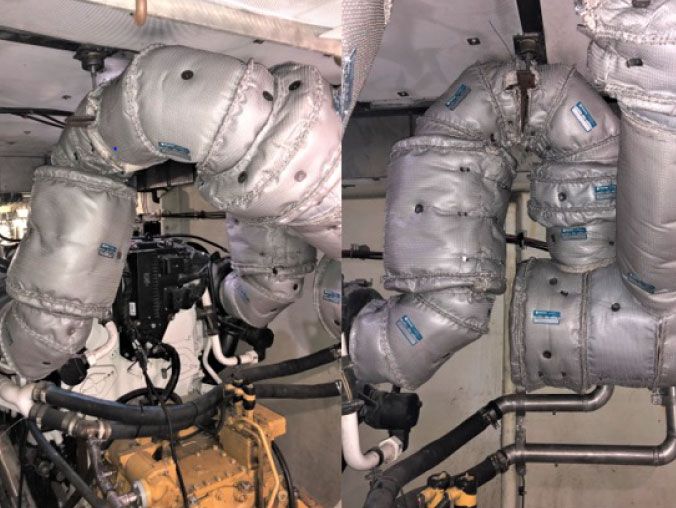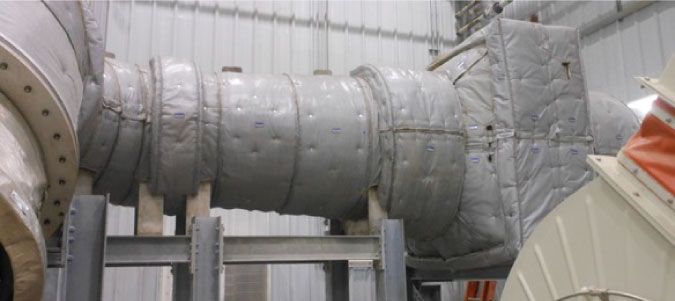Insulation blankets for engine exhausts are the hallmark application for removable, reusable thermal blanket insulation. Thermal applications are still propelling the adoption and development of blanket insulation technology since first used aboard ships 90 years ago. In 1991, I visited the Maine Maritime Museum in Bath, Maine, and toured a fishing schooner, which one of its owners modified from sail to engine power in the 1930s. This historic vessel had some of the earliest versions of insulation blankets for engine exhausts. As a lifelong advocate for (and professional manufacturer of) blanket insulation technology, this ship was a treasure and confirmed the marine industry has long seen the benefits of removable, reusable insulation. Exploring the schooner confirmed the fundamental purpose and unique advantage of reusable insulation versus conventional insulation materials.
While the concept for a flexible and removable, reusable insulation system, which is self-contained, comes from the maritime industry, the solution has evolved to benefit industries ranging from oil & gas to food processing. Think about removing insulation materials at sea to access a piece of equipment for service, inspection, or repair. It’s a common practice to remove insulation when servicing engine exhaust systems. But replacing that insulation with new materials wasn’t an option for crews because a ship carries only what it must. Mechanics reuse what they have onboard or leave things uninsulated after performing service.
In the early days of the maritime industry, insulation blankets for engine exhausts consisted of an asbestos cloth and asbestos insulation stapled or “hog ringed” together. Once constructed, and installed, workers painted the outer cloth of the finished blanket to match the pipe insulation. These primitive designs were functional compared to hard insulation. But removing and reinstalling the asbestos insulation required a trained, skilled mechanic.
The concept of removable and reusable insulation upended the way people thought about maintenance and engine efficiency. The industry learned that insulation material that workers could remove and reinstall paid for itself many times over when compared to the cost of repeatedly purchasing conventional, hard insulation or leaving components bare. Other benefits of reusable insulation for a ship’s crew included:
- easily accessing components, which enabled workers to service things on the fly,
- reducing dust and other free-floating airborne fibers,
- eliminating the need to buy new materials,
- better engine efficiency,
- doing away with forming, cutting, and fabricating new materials for conditions aboard ship, and
- lowering acoustic energy.
Crews could simply reinstall an insulation blanket and walk away. A ship’s mechanic gained quick access to service a component. Reusing an insulation blanket saved labor for removal and reinstallation. Reusable insulation blankets were and still are a symbol of “sustainability,” before sustainability was the topic du jour.
A challenging application to insulate
Engine exhaust applications are high temperature (i.e., 650 to 1300 Fahrenheit) depending on the type of engine (e.g., 2 cycle, 4 cycle), and they vary in size with exhaust piping from 6” to 60” OD, all presenting a challenge. Aboard ship, there is a constant motion and vibration that adds complexity to designing insulation that’s easy for crews to remove and reattach. When a manufacturer designs thermal blanket insulation specifically for the application and tests the product to stand up to extreme conditions like heat and vibration, crews gain all the benefits mentioned above.
Beyond the sea
With the success of reusable thermal insulation in the maritime industry, the stage was set for a new technology applicable to other industries. In 1977, insulation manufacturers began introducing reusable thermal solutions for the commercial and industrial market. Private industry embraced the concept and invested in blanket insulation solutions for refineries, chemical plants, steam systems, and more. By some estimates, today’s blanket insulation market is worth $500 million.
Even the designs and concepts from the late 1970s proved reusable insulation systems could reap benefits for employers. Just as they had tackled the complexity of blanketing marine engine exhausts, blanket insulation companies presented solutions for covering complicated industrial applications. More than 40 years later, the solution for saving energy and reducing greenhouse gases is still a well-designed, tested reusable cover.
Developments in the 1970s with CAD and CNC technology greatly enhanced the design of reusable insulation blankets, including the accuracy of fit and quality of the product. Technological advances in insulation fabrics and jacketing (e.g., PTFE, silicone, hybrid laminates, coatings, stainless steel, ceramics, etc.) allow blanket manufacturers to accommodate extreme conditions to meet remarkable customer challenges. When a manufacturer properly designs and makes a blanket system to meet a detailed specification and tests that system to ASTM, UL or ISO standards, the result is a solution that can tackle temperatures up to 2000 F or reduce noise by 4 to 15 dBA. Blanket systems like these improve efficiency and save energy.
Reusable thermal insulation started with shipboard applications. In fact, Shannon Global Energy Solutions still covers complex engine exhaust surfaces with thermal and acoustic blanket insulation. Nearly 90 years after crews began using rudimentary, but effective, reusable insulation blankets, the concept has evolved and grown exponentially. Thanks to an enterprising group of mechanics who looked for a sustainable insulation solution while managing engines at sea, virtually every industry now reaps the benefits of reusable insulation.


